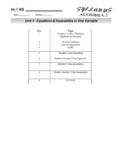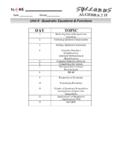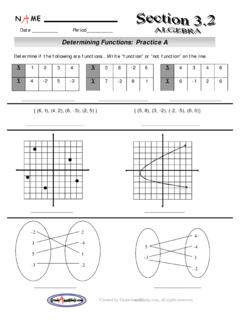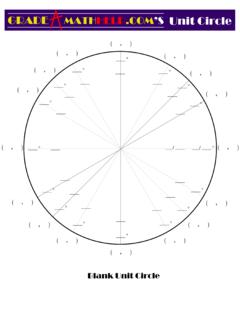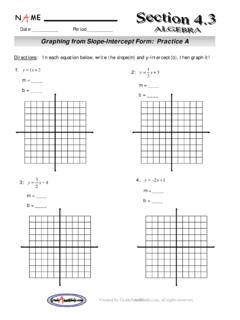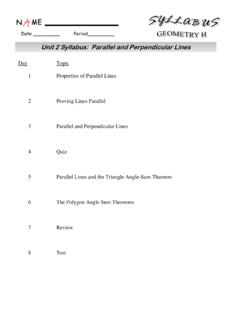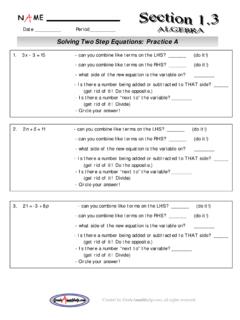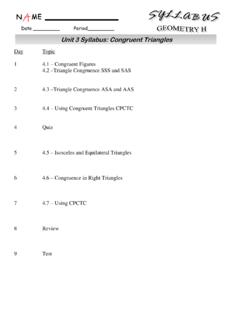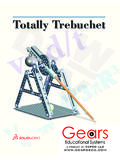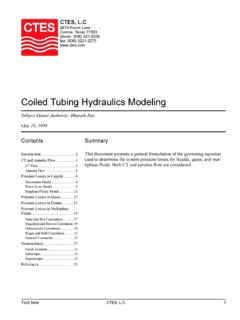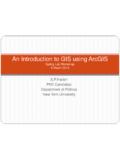Transcription of Unit 8 Syllabus: Surface Area & Volume
1 Day Topic 1 Space Figures and Cross Sections 2 Surface area and Volume of Spheres 3 Surface area of Prisms and Cylinders Surface area of Pyramids and Cones 4 Volumes of Prisms and Cylinders Volumes of Pyramids and Cones 5 Review 6 Quiz 7 Areas and Volumes of Similar Solids 8 Review Review Sheets/Study 9 Test To Be Determined Date _____ Period_____ Unit 8 syllabus : Surface area & Volume 1 1.
2 Use your book, your friends, and your brilliant teacher to define and fill in the a) Polyhedron:; b) Face: c) Edge: d) Vertex: e) Euler s Formula: Use Euler s Formula to find the missing number. 1) Faces: 5 2) Faces: 3) Faces: 8 Edges: Edges: 9 Edges: 18 Vertices: 5 Vertices: 9 Vertices: Using the demonstration given on a cross section, describe it below. Formal Definition (cross section): Date _____ Period_____ Unit 8, Day 1: Space Figures & Cross Sections (S 11-1 ) 2 Determine the cross section of each figure below.
3 A) B) C) Using the demonstration given, describe what is meant by the net of a polyhedron. Match each polyhedron with it s net below. 1) 2) 3) 4) A. B. C. D. 3 Explanation of Figures: Prism, Cylinder, Pyramid, Cone, Sphere 4 Date _____ Period_____ Formula Sheet Volume and Surface area (Unit 8 ) B = area of base P = perimeter of base C = circumference of base l = slant height of polyhedron h = height of polyhedron L E G E N D 5 2. A sphere is a set of points in space ___equidistant_____ from a point called the center.
4 Define the following: Radius: a segment that has one endpoint at the center and the other endpoint on the sphere Diameter. A segment passing through the center with endpoints on the sphere Great Circle: if the center of a circle is also the center of the sphere, then it s a great circle. Hemisphere: a half sphere - a great circle divides a sphere into two hemispheres. Example: What is the Volume and Surface area of a sphere with radius 5? ( )( )3445005125333V === ( )( )245425100SA === Date _____ Period_____ U8D2 Volume and Surface area of Spheres From your formula Sheet 6 1.
5 Find the Volume and Surface area . 2. Find the Volume and Surface area . 3. The Volume of a sphere is 1200 ft3, what is the radius? What is the Surface area ? 4. The circumference of a basketball is approximately 75 cm, how much leather does it take to make the basketball? 5. An ice cream cone 6 inches tall, with a 2 inch radius is completely filled, including a perfect hemisphere sitting on top. How much ice cream is there? 14 in. 12 in. 7 1. Describe, compare, and contrast the words lateral area , base area , and Surface area 2.
6 Which figures have 2 bases and which figures have only 1 base? 3. What does the letter represent on your formula sheet? Name the word & describe it. 4. The Cylinder and Prism are the except the base is a circle instead of a polygon. area of Base Circle = 2r Triangle = 12bh Rectangle = bh Polygon = 12ap Length around the base Circumference = 2r Perimeter = add up all sides Lateral area LA = 2 Chrh = LA = Ph= Perimeter height Surface area SA = LA + 2B = 222rhr + SA = 2 PhB+ Date _____ Period_____ U8D3: Surface area Prisms, Cylinders, Cones, Pyramids 8 5.
7 The pyramid and the cone are the same, except the base is a circle instead of a polygon. area of Base Circle = 2r Triangle = 12bh Rectangle = bh Polygon = 12ap Length around the base Circumference = 2r Perimeter = add up all sides Lateral area LA = 122rlrl = LA = 12Pl= Perimeter slant-height Surface area SA = LA + B = 2rlr + SA = 12 BPl+ 1. Right Rectangular Prism B = _____, h = _____, P = _____ LA = _____, SA = _____ 12 4 18 9 2. Right Square Pyramid B = _____, h = _____, P = _____, l = _____ LA = _____, SA = _____ 3.
8 Right Cone B = _____, h = _____, C = _____, l = _____ LA = _____, SA = _____ 4. Right Cylinder B = _____, h = _____, C = _____ LA = _____, SA = _____ ? What are the formulas for the Surface area of a prism, cylinder, pyramid and cone? Compare and contrast them 10 Notes presented on powerpoint. All formulas are listed on your formula sheet Racecar game continued. You may make a note card for tomorrow s quiz! Date _____ Period_____ U8D4: Volumes Prisms, Cylinders, Cones, Pyramids Date _____ Period_____ U8D5: Review for Day 6 Quiz 11 1.
9 In the space below, describe and draw Describe and draw similar solids a pair of similar polygons 2. Describe a one-dimensional measurement 3. Describe a two-dimensional measurement 4. Describe a three-dimensional measurement 5. Fill in the chart below by naming each variable from your formulas sheet, and determining what dimension it is. Variable Name Dimension V B h P SA C l r Date _____ Period_____ Unit 8, Day 7: Areas/Volumes of Similar Solids (S 11-7) 12 6. Reminder: The _____ _____ of two similar figures gives the ratio of the corresponding linear (1) dimensions of the figures.
10 7. Refer to the chart from the warm up to determine what dimension each variable 8. Example: Two similar cones have radii in the ratio of 4:5. a) What is the ratio of their heights? b) What is the ratio of their Surface areas? c) What is the ratio of their volumes? d) The smaller cone has a Volume of 42 . What is the Volume of the larger cone? 9. The ratio of the Surface areas of two similar prisms is 9:16. What is the ratio of their volumes? If the similarity ratio of two similar solids is given a:b, (1) the ratio of their corresponding ( Surface ) areas (2 dimensions) is (2) the ratio of their volumes (3 dimensions) is 13 10.
